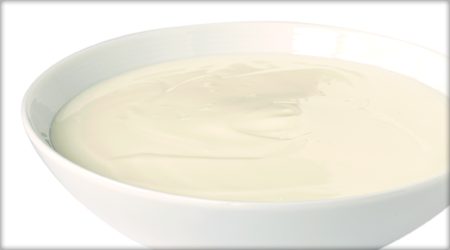First, what is yogurt? According to culturesforhealth.com “yogurt is the product of beneficial bacteria fermenting milk and turning it into a thickened, acidic food that will stay fresh longer than milk itself, and that contains millions of bacteria that are welcomed by the human digestive system.”
 Yogurt is produced using two primary forms of bacteria. Lactobacillus, or lactic acid bacteria, takes the naturally occurring lactose and other sugars found in milk and converts them into lactic acid which gives yogurt its texture and tart flavor. Lactic acid is also naturally produced by the human body, particularly during exercise, and has been found to generate anti-inflammatory and anti-cancerous activities. Just as important is the bifidobacteria that are commonly added during or after the yogurt’s fermentation process. Consumers typically hear bifidobacteria referred to as probiotics. These probiotics help “to break down the food you eat into byproducts such as lactic acid and hydrogen peroxide, both of which make it hard for harmful bacteria to grow,” as referenced by Livestrong.com. In other words, probiotics found in yogurt can boost your immune system, aid in the production of naturally occurring vitamins within the human body, and decrease the amount of time your body takes to naturally break down and metabolize food to create the energy you need for a fit and healthy lifestyle.
Yogurt is produced using two primary forms of bacteria. Lactobacillus, or lactic acid bacteria, takes the naturally occurring lactose and other sugars found in milk and converts them into lactic acid which gives yogurt its texture and tart flavor. Lactic acid is also naturally produced by the human body, particularly during exercise, and has been found to generate anti-inflammatory and anti-cancerous activities. Just as important is the bifidobacteria that are commonly added during or after the yogurt’s fermentation process. Consumers typically hear bifidobacteria referred to as probiotics. These probiotics help “to break down the food you eat into byproducts such as lactic acid and hydrogen peroxide, both of which make it hard for harmful bacteria to grow,” as referenced by Livestrong.com. In other words, probiotics found in yogurt can boost your immune system, aid in the production of naturally occurring vitamins within the human body, and decrease the amount of time your body takes to naturally break down and metabolize food to create the energy you need for a fit and healthy lifestyle.
As diets, cultures and societal trends have evolved, so has our use and consumption of yogurt and yogurt-based products. At some point in our lives we’ve all been exposed to yogurt. Its different flavors, textures, applications and seemingly endless health benefits make it a staple in many diets. You can get so much of your necessary fat and protein from one serving of yogurt daily. It also contains calcium, riboflavin, vitamins B6 and B12, which are all essential ingredients for lasting energy throughout the day. There are also nonfat and low fat yogurts for those keeping a very close eye on their waistline.
There are several different kinds of yogurt consumed around the world. To many, especially in the U.S. market, frozen yogurt is the be-all-end-all of yogurt … to most, there is no other worth mentioning. Well, it turns out there are several kinds, and it is time to shine a little light on the major players in the yogurt arena.
Balkan or Set-style Yogurt
Balkan or set-style yogurt is often much thicker than other types of yogurt due to the process by which it is made. The fermentation takes place in individual containers rather than in a large vat, with no stirring, which gives the end product a smoother texture and added flavor. This style of yogurt is often enjoyed plain or added to recipes for texture. According to ediblecommunities.com “in Balkan cooking, it is often used as a substitute for sour cream or salad dressing. Because yogurt is highly acidic, it’s also great as a low-fat substitute in baking.”
Swiss-style or Stirred Yogurt
Perhaps the most-commonly found yogurt in the U.S. is Swiss-style or stirred yogurt. Unlike Balkan-style, the fermentation takes place in a large vat and the yogurt is then cooled and stirred to ensure a creamy texture. It maintains a slightly thinner consistency and is typically consumed plain or flavored with fruit. You will see this style most often used in cold beverages or incorporated into desserts.

Greek-style Yogurt
Greek or Mediterranean-style yogurt is produced by removing the water or whey protein to ensure a very thick consistency and creamy texture. This style of yogurt has become very popular all over the globe in recent years. It is often used for cooking as it tends to hold up better than the other styles of yogurt, can be consumed plain or frozen and provides a great texture and flavor for making snack dips. And let’s be honest, who doesn’t love a good snack dip! An interesting fact, a Balkan-style yogurt with 6% milk fat or more is an excellent substitute for Greek yogurt.
Low-Fat Yogurt
For those who are weary of sacrificing flavor to go totally nonfat, low fat yogurt is nearly as healthy while still giving you the texture and flavor you’re accustomed to. It is classified as any yogurt containing 0.5–2% milk fat. Common uses for low fat yogurt include a replacement for sour cream to top your baked potato, as a base in homemade snack dips, added to instant muffin or bread mixes and combined with baking soda rather than using butter or oil, added to crushed ice and your favorite fruits for a protein-packed smoothie, mixed into chilled soups for a creamy texture, or even as a tangy salad dressing or as a sauce for chicken or tuna.
Nonfat Yogurt
By its simplest definition nonfat yogurt is classified as any yogurt containing 0.5% milk fat or less. A healthy alternative to traditional yogurt, nonfat yogurt is offered in a plethora of flavors. It does maintain a slightly thinner consistency than traditional forms of yogurt. Some surprising uses for nonfat yogurt include using it as a substitute for sour cream, to make a homemade dip, straining it then adding salt to create a yogurt cheese used to top pasta dishes, or even using it as the base for marinade to pair with a pork or poultry dishes. This style of yogurt will keep you guessing, all while watching your figure!
There is much more to yogurt than just freezing it to serve as a summertime treat. There are many different applications for it not only in the culinary world, but in everyday life for those not interested in making it part of their diet. If you would rather use it to exfoliate your skin or to polish brass and other household items, feel free to do so. This fascinating creation is also used as a digestive aid or to prevent and lower high blood pressure. Any way you look at it, yogurt has become a staple in our daily lives, our diets, and trends suggest its uses will continue to evolve and overtake our world one serving at a time. So here’s to yogurt!
References:
Cultures for Health
(n.d.). What is Yogurt? Retrieved from http://www.culturesforhealth.com
Edible Communities(n.d.). Thick and Creamy, Rich and Dreamy Retrieved from http://www.ediblecommunities.com
Dairy Goodness(n.d.). Types of Yogurt Retrieved from http://www.dairygoodness.ca
Food Timeline(n.d.). Yogurt Retrieved from http://www.foodtimeline.org
Health(n.d.). 4 Surprising Health Benefits of Yogurt Retrieved from
http://www.health.com
Livestrong(n.d.). What Does Lactobacillus Acidophilus Do In Yogurt? Retrieved
from http://www.livestrong.com
